1897 Indian Head Penny Coin Value: How Much Is It Worth?
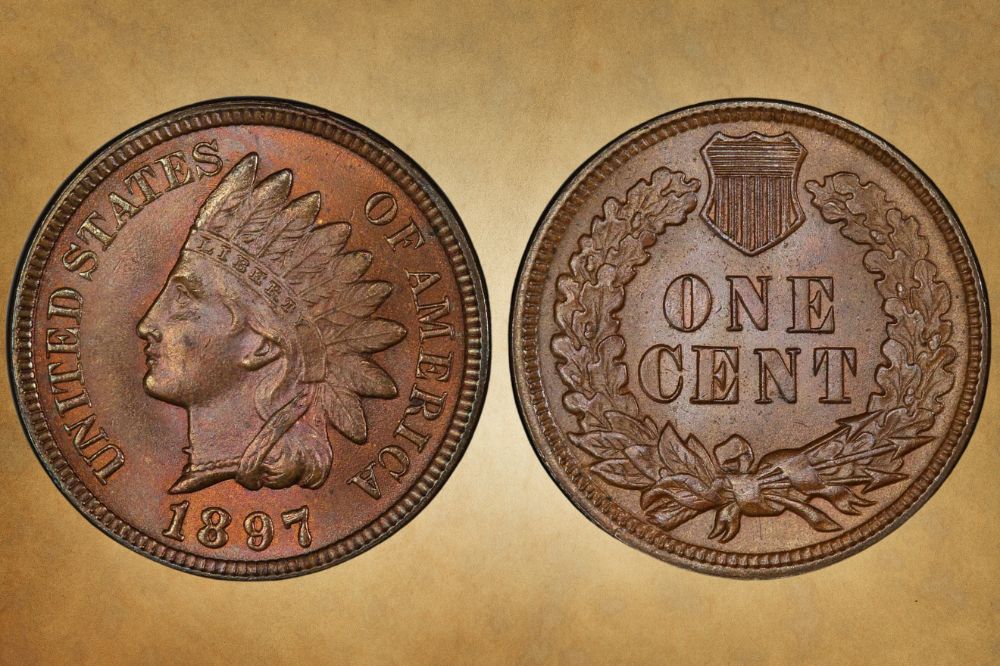
Today, we might refer to Indian Head Pennies as Native American Head Pennies. Either way, they were the first US coins to incorporate nickel. And yes, this was connected to the 1850s gold rush and its effect on copper prices. But more on that later. Let’s begin by studying the 1897 Indian Head Penny Value and understanding the emblematic significance of this coin.
1897 Indian Head Penny Value Chart |
|||||||
| Mint Mark | Good G 4 | Fine
F 12 |
Extremely Fine
EF 40 |
About Uncirculated
AU 50 |
Uncirculated MS 60 | Mint State
MS 63 |
Proof PR/PF 65 |
| 1897 (P) No Mint Mark Indian Head Penny Value | $3.30 | $5.70 | $17 | $28 | $45 | $115 | $169 |
1897 Indian Head Penny Value Guide
In 1897, pennies were only minted in Philadelphia so they didn’t have mint marks. But being copper coins, they were typically color-graded as RD for red, RB for reddish-brown, or BN for brown. RD coins are the most expensive. To confirm the condition of a coin, you can send it to a reputable coin grading company and pay a small assessment fee for a slab and a grade.
The best-known coin assessors are ANACS (American Numismatic Association Certification Service), NGC (Numismatic Guaranty Company), and PCGS (Professional Coin Grading Service). They grade business strike coins aka circulation coins or regular strikes from 1 to 70 based on the Sheldon Coin Grading scale. Higher numbers are generally more valuable.
They also grade collector’s coins e.g. proofs, uncirculated sets, and special strikes. Proofs are graded as PF by NGC and PR by PCGS while special strikes are graded as SP for Specimen or Special Proof. They might also be graded SMS for Special Mint Set. These also go from 1 to 70. If a coin looks like a proof but it’s a circulation strike, it’s marked as PL, DPL, or DMPL.
This means Proof-Like, Deep-Proof-Like, or Deep-Mirror-Proof-Like. Finally, coins that have been improperly cleaned, chemically altered, or damaged might be graded as Details (1 to 58), Brilliant Uncirculated (60 to 70), Choice Uncirculated (63 to 70), or Gem Uncirculated (65 to 70). These extra grades are often used without their accompanying numerical grade.
1897 (P) No Mint Mark Indian Head Penny Value
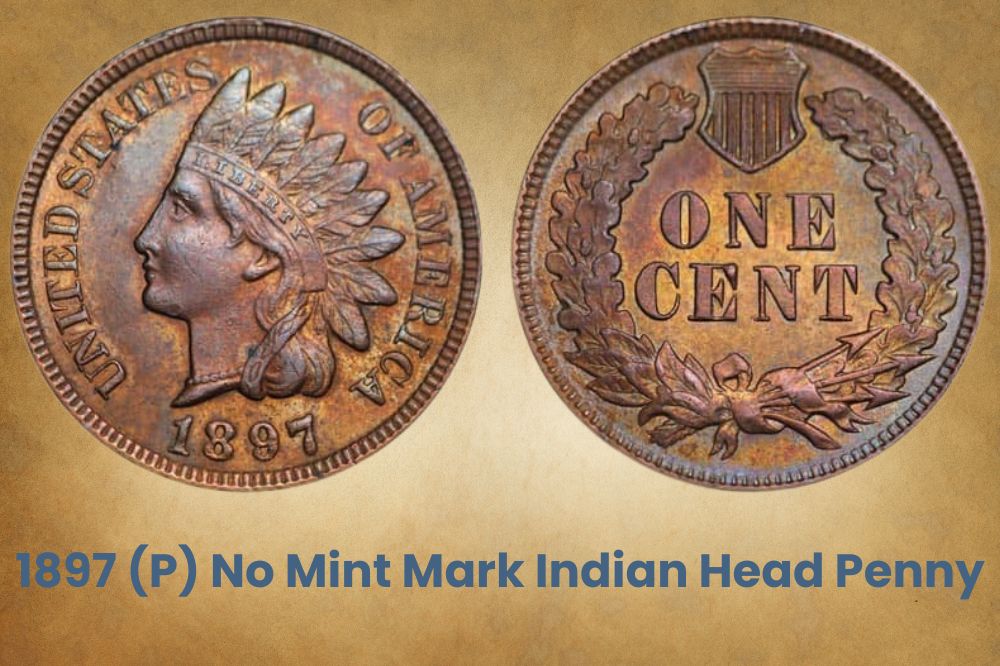
In 1897, the US Mint made 50,464,392 coins in Philadelphia. They had no mint marks. In June 2011, an MS 64 BN sold for $865. But by November 2022, an MS 65 BN was only worth $192 with over twenty coins graded. PCGS estimates the value of an MS 65 BN as $250. As for RB pennies, an MS 66 RB sold for $1,400 in March 2021, down to $1,140 in March 2022.
RD pennies do much better. An MS 67+ RD sold for $45,600 in August 2019 though an MS 67 was only $10,500 in January 2021. So far, the highest grade submitted to PCGS is MS 68. Only one coin is known so PCGS estimates its 2023 value as $135,000. The most recent sales recorded by PCGS were two MS 66 RDs that sold for $5,523 and $7,050 in December 2022.
1897 (P) Proof Indian Head Penny Value
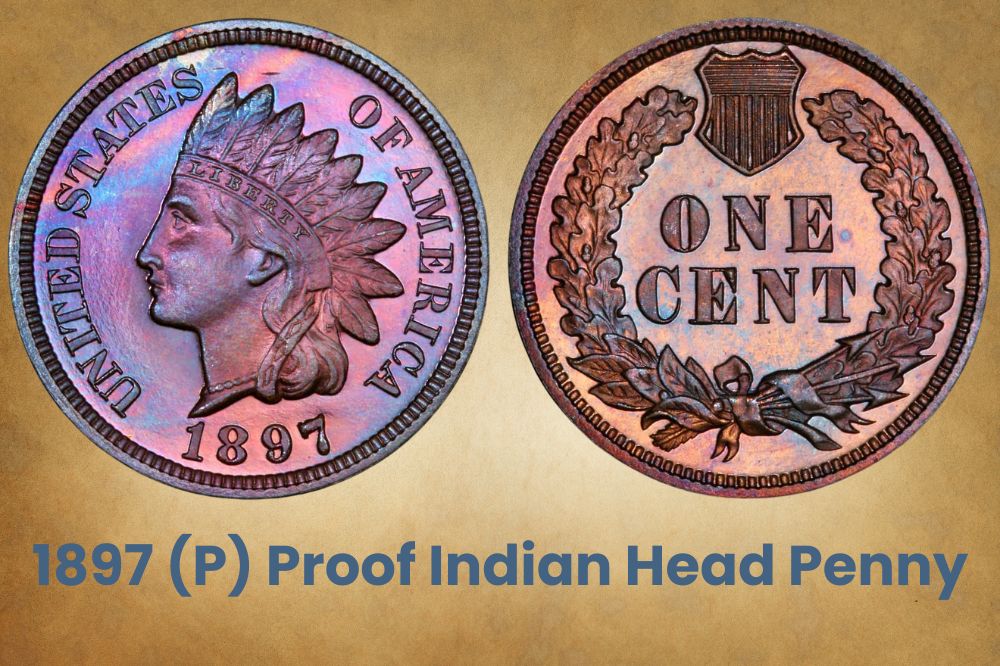
Proof coins were invented as the official way to test dies. They were minted on superior planchets to confirm the details were sharp and clear. This way, the mint could ensure the dies were accurate and effective. A copy of the proof coin is usually kept in the archives or given to museums and the rest are sold to collectors at premium prices for extra revenue.
These coins come in three styles – matte, mirror-like, and reverse proofs. In 1897, the mint made mirror-like proofs, which meant the field was mirror-like and the device was frosted. The frosting was done using an early acid-pickling technique that continued until 1970. This method made the first 50 to 100 coins extra shiny, so they were graded Deep/Ultra Cameo.
But since the acid wash faded every time the die struck a planchet, the next 100 coins or so would just be cameo and the rest would be standard proof coins. After 1971, this fading was resolved by switching to laser frosting. As for the mirrored parts of a coin, they were crafted through two techniques. First, the dies were scrubbed with horsehair brushes for extra shine.
Pricing the 1897 Indian Head Proof Penny
The planchets intended for proof coins were tumbled in a vat full of 6mm stainless steel balls called satellites, then rinsed to remove any residue. This burnished the planchets to achieve a mirror-like sheen before they were struck into proof coins. For reference, the planchets used for regular strikes and even special strikes aren’t pre-burnished so they’re a lot less shiny.
That’s the main difference between a PR/PF and a PL/DPL/DMPL since the latter sets use normal unburnished planchets. In 1897, the Philadelphia Mint made 1,938 Indian Head Proof Pennies. In August 2016, a PR 67 BN was $3,100. A PR 67+ BN is $3,500 in 2023. A PR 68 RB was $10,350 in June 2008. Only one is known, estimated at $12,500 in 2023.
Meanwhile, a PR 68 RD sold for $20,700 in July 2002. In August 2019, a PR 67 CAM sold for $40,800 and PCGS estimates its value at $32,000. A PR 68 CAM was $34,500 in August 2004 and is estimated at $45,000 in 2023. At the apex, a PR 67+ DCAM was $108,000 in March 2021. But PCGS has only graded two and estimates their value at $110,000 in 2023.
Related Posts: 16 Most Valuable Wheat Penny Errors
1897 Indian Head Penny Errors
If you’re starting out in the coin field, you may think the faded or weak N at the back of many 1897 Pennies is an error. It’s on the word One in the denomination, and the E in cent tends to fade as well. But these were die markers that made many coins wear out faster at the spot, especially since people often hold that part of the coin when they’re handling 1897 pennies.
That said, true mint mistakes can raise the resale value of a coin. They include doubling, off-centers, misalignment, wrong planchets, and overstruck foreign objects. Doubling, tripling, and re-punched mint marks happen if the die moves between hub strikes so that the next impression lands somewhere else. Off-centers happen if the planchet moves before striking.
1897 (P) Indian Head Penny RPD Error
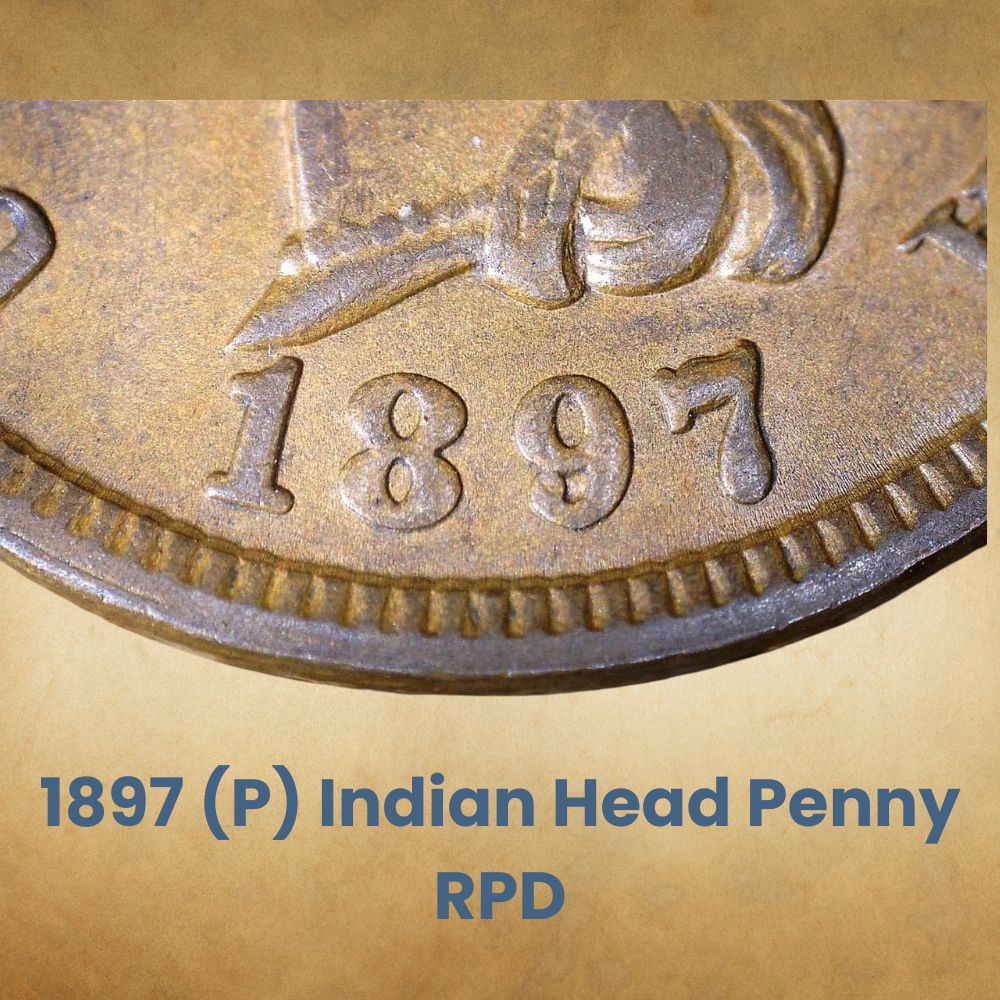
RPD means re-punched date and it happens when the second or third strike of the date landed on a slightly different spot. You can see traces of the earlier dating peeking out underneath. An MS 64 BN was $216 in June 2021. The highest known grade is MS 65 BN. Its value is estimated at $400 in 2023. Meanwhile, an MS 65 RB sold for $780 in August 2021.
1897 (P) Indian Head Penny MPD aka 1-in-Neck Error
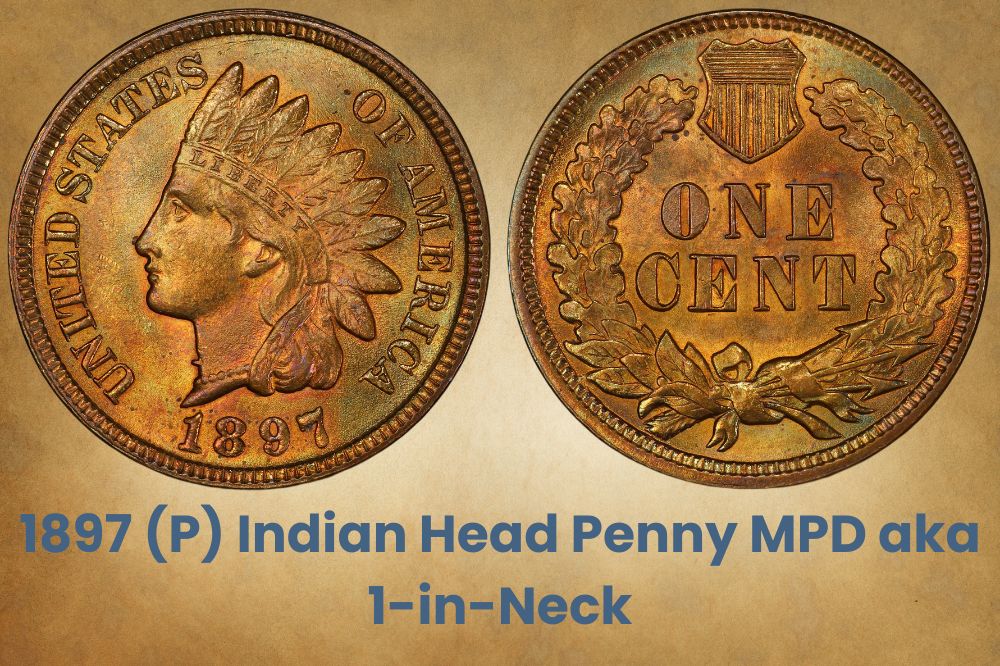
MPD means misplaced date. There’s an extra 1 on the coin, hinting that an additional 1897 was struck inside Lady Liberty’s neck. You can see the serifs of the 1 poking out near her pearls, hence the 1-in-neck error. An MS 64 BN was $3,360 in January 2021 and an MS 64 RB was $8,913 in June 2007. An MS 64 RD was $4,080 in April 2021. It’s $4,250 in 2023.
1897 (P) Indian Head Penny Cleaned Double Struck
Firstly, if you find a dirty coin, don’t and clean it! That lowers its grade and value. Secondly, a double strike means the completed coin was struck again while exiting the coin press aka mechanical doubling. It differs from a doubled-die because the error was on a finished coin.
But if the doubling error occurs on the die, it gets copied on every coin it strikes. This creates a variety i.e. a coin batch with identical errors and/or features. As we said, cleaning dropped the grade to VF Details so it only sold for $335 despite that potentially pricy double strike.
Related Posts: 19 Most Valuable Lincoln Memorial Penny Worth Money
History of the 1897 Indian Head Penny
The Indian Head Penny had several iterations during its five decades of circulation (1859 to 1909). The coin was designed by Chief Mint Engraver James Barton Longacre to replace the Flying Eagle Cent he had designed in 1857. But he didn’t sign the coin until somewhere in the 1860s, probably after the coin became legal tender. His monogram helped to authenticate it.
From 1857 to 1864, the Indian Head Penny was 88% Copper and 12% Nickel. Before that (1792 to 1856), pennies were pure copper. But in the 1850s, the gold rush affected the cost of all metals including silver and copper. The abundance of gold made silver and copper rarer in comparison. So their prices shot up and people started hoarding silver and copper coins.
This was a problem for copper coins because, at the time, they weren’t legal tender. You could use them for everyday transactions, but you couldn’t pay taxes or government fees in copper. Also, the price hike pushed the melt value of copper ever closer to its face value, affecting the production cost of copper coins, which were the biggest source of revenue for the US mint.
It all comes down to seignorage, which is the gap between production cost and face value. This difference is counted as a tax and boosts the US mint’s bottom line. The previously low price of copper meant the penny and half-penny were the mint’s most profitable coins. For reference, coins above 5 cents (half disme) were silver, and their seignorage was way lower.
The Effect of the Gold Rush on Silver and Copper Coinage
When the copper hike happened, the mint responded, first by reducing the physical size of the 1-cent coin to reduce its face value. They did this in 1857, introducing the new Flying Eagle Penny to mark the change. They also altered the metal composition from pure copper to 88% Copper and 12% Nickel. But the Flying Eagle design had many points of high relief.
These needed additional strikes to clearly bring out the images. And since nickel is a harder metal, the dies deteriorated faster. The mint had to spend unplanned cash on repairing and replacing steel dies, which cut deep into seignorage figures. The next solution was to change to the Indian Head Penny, a design that was gentler on dies since it required fewer strikes.
Then in 1864, Congress officially accepted copper coins as legal tender, expanding their usage in federal contexts. By this time, the spot price of copper was down to a reasonable level, so the 1-cent coin changed its metal composition once again, settling at 95% copper with 5% in zinc, tin, or sometimes both. Except for 1943, this new alloy was used until 1982.
The Indian Head Penny was popular with the public and was used until 1909 when the mint introduced the Lincoln Cent. This commemorative coin celebrated 100 years since Abraham Lincoln’s birth was the first circulating coin to feature an American President, and was the result of a coin beautification project requested by President Theodore Roosevelt in 1904.
Related Posts: 19 Most Valuable Wheat Penny Worth Money
How to Identify 1897 Indian Head Penny?
Every specialty has a set of terms that makes it easier to discuss their hobby or industry. And numismatists are no different. In case you’re unfamiliar, these are people who collect and study coins, medals, and sometimes paper currency. When they’re talking about coins, they use certain jargon, so we’ll mention a few of these technical words to help the uninitiated.
The front or heads side of a coin is called its obverse and the tails side is the reverse. The thin sides are called edges, and on larger denominations like dimes, quarters, half dollars, dollars, and above (quarter eagle, half eagle, eagle, and double eagle aka $2.50, $5, $10, and $20), they have ridges called reeds. Usually, pennies and nickels don’t have reeds on their edges.
Older coins may also have tooth-like beads aka denticles on the rim. The rim or collar is the raised border that maintains the shape and thickness of a coin. The words struck on a coin are called mottos or legends while the images are known as devices. The background of the coin is known as the field. All these design details are struck on blank discs called planchets.
The Obverse of the 1897 Indian Head Penny
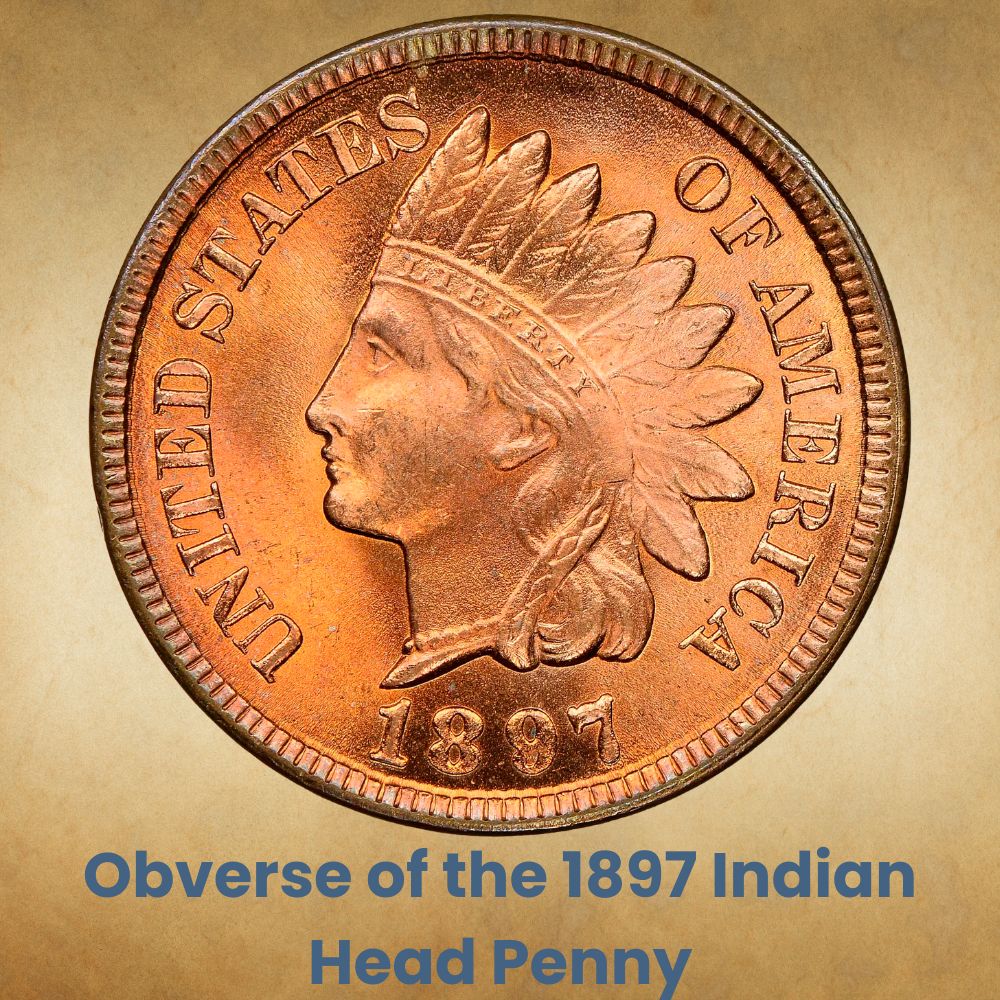
The obverse (heads side) of the 1897 Indian Head Penny shows a young Lady Liberty in a Native American man’s feather headdress with Liberty on the headband. She wears a string of pearls and the mint date is under her neck. The designer’s initial, L for Longacre, is in her hair next to the last feather. United States is in front of her with Of America behind her head.
The Reverse of the 1897 Indian Head Penny
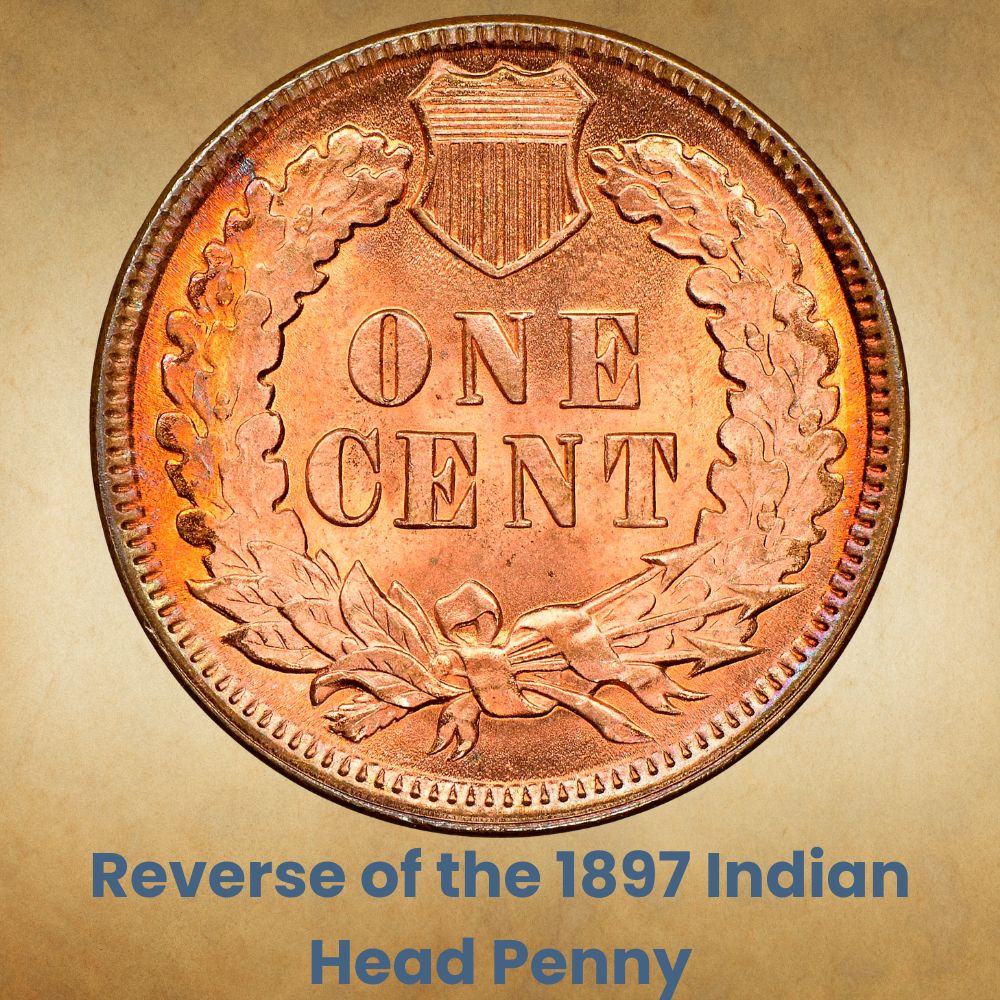
The reverse (tails side) of the 1897 Indian Head Penny features oak and laurel sprigs woven into a wreath. The top of the wreath is open, with a shield slipped into the empty space. The bottom of the wreath is tied with a ribbon that holds three arrows pointing to the right. The coin’s denomination, One Cent, sits in the middle of the wreath at the center of this penny.
Other Features of the 1897 Indian Head Penny
The 1897 Indian Head Penny was 95% Copper with the remaining metal being tin, zinc, or both (about 5%). It weighed 3.11g and measured 19.05mm in diameter (0.75 inches). It had no reeds so the edge was described as smooth or plain. As an older coin, it featured denticles on the front and back, running all around the rim. This 1c coin doesn’t have any mint marks.
FAQs About the 1897 Indian Head Penny
How Much is an 1897 Wheat Penny Worth?
The 1897 Penny had an oak wreath and a shield on the back, so it was never referred to as a Wheat Penny. Instead, it was known as the Indian Head Penny because Lady Liberty wore a Native American man’s headdress on the front of the coin. On the other hand, Wheat Cents or Wheat Pennies had Abraham Lincoln on the front and two wheat stalks on the back. They were used from 1909 to 1958, and they were nicknamed Wheat Pennies to distinguish them from other Lincoln Cents that had a different design on the back e.g. Memorial or Shield Cents. That said, an 1897 Indian Head Penny graded MS 68 is worth $135,000 in 2023.
What is an 1897 Error Indian Head Penny?
The most recognized error on the 1897 Indian Head Penny is the MPD or misplaced date, sometimes called the 1-in-Neck error. On the obverse die, an extra date was punched inside Lady Liberty’s neck, and you can see the serif of the 1 peeking out in front of her neck, above her pearls. In 2023, PCGS estimates this 1897 Penny MPD Error at $3,500 for MS 65 BN, $5,000 for MS 65 RD, and $4,250 for MS 64 RD. These are the highest grades submitted.
